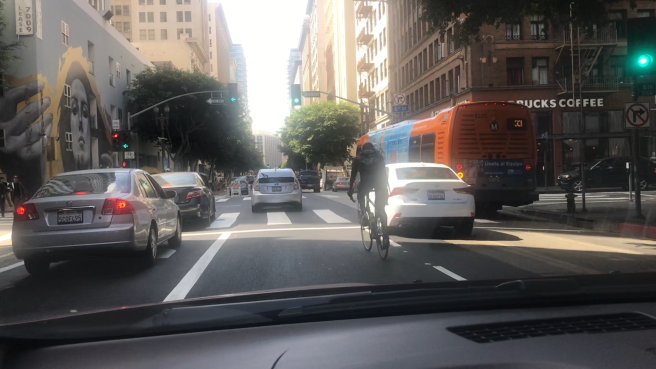A sliver of sanity.
journalism/law/muckraking
Bike lane reversals are slivers of sanity reflecting a growing national trend

Perhaps the most surprising reversal has come in Seattle. To hear the bike activists (or “non-auto mobility advocates”) tell it, Seattle ought to be a premier bicycling city. It’s one of the country’s most progressive locales, with substantial populations of Millennial and Gen Z folks who are the most likely cohorts to use bikes and other alternative transportation. The metro area is fairly compact, with a downtown core and other dense pockets like Ballard, and it’s well-served by transit. It’s increasingly expensive to own a car, and traffic is getting worse all the time (of course much of that congestion has to do with all the bike and transit infrastructure). The city even has a former mayor nicknamed “McSchwinn” (not intended as a compliment, mind you).
But to the extent there ever was one, the city’s love affair with the velocipede is proving short-lived and tempestuous. A recent Seattle Times/Elway poll revealed that barely 40% of city residents support the continued expansion of bike infrastructure, while 56% oppose it. Most revealingly, slightly more urban Seattlites “strongly” opposed more bike lanes. To be sure, like any poll there are flaws with this one, in particular its over-reliance on homeowners who are more likely than renters to own cars. Still, it reflects a national trend of cooling enthusiasm and even outright opposition to the mindless expansion of bike facilities at the expense of drivers and bus riders, not to mention first responders. And alternatives to cycling such as ride sharing, car sharing, e-bikes, and scooters continue to proliferate, giving people more attractive options than old-fashioned pedal bikes.
The bike wars came to a head in the Emerald City over a proposed “road diet” on 35th Avenue. Part of the city’s Bicycle Master Plan, the project would have reduced the street from four lanes to two, with protected bike lanes in both directions. Two competing groups, Save 35th (opposed) and Safe 35th (in favor) spent the last 18 months engaged in a sometimes ugly clash over the proposal. The city even hired a mediator to try to find a compromise, to no avail. Eventually the city announced that it would move forward with the project, but sans protected bike lanes.
Despite a decades long push by a small but well-funded, well-connected, and above all noisy cohort of activists the proportion of Americans commuting by bicycle is decreasing. According to the Census Bureau, between 2016 and 2017 bicycle commuting dropped by 25.8% in Oakland, 19.9% in San Francisco, 24.1% in Austin, more than 13% in Atlanta, and more than 12% in Boston. According to the League of American Cyclists, during that same period the overall number of people who regularly commute via bicycle declined in 30 of the 50 states. Reason Magazine reported similar statistics last year. Only four cities – Davis, Santa Cruz, and Palo Alto, California as well as Boulder, Colorado – cracked double digits, barely, and those are all locales with considerable populations of students and other young people.
Of course, these trends could just be blips. After all, overall cycling increased by nearly 43% nationally between 2000 and 2016. Bolstered by federal highway funds hundreds if not thousands of cities and towns across the country, from New York, New York to Waverly, Iowa, continue to invest untold billions in infrastructure, lanes, and other improvements for bicycling. And, of course, one year hardly makes a trend. Then again, while the increase sounds significant in percentage terms the number of Americans for whom cycling is their primary mode of getting around remains vanishingly small.
Regardless, considering those billions of dollars that federal, state, and local agencies collectively have spent on bike infrastructure (at one point the City of Seattle was willing to spend as much as $12 million per mile on dedicated bike lanes) these reversals amount to a stunning rebuke. Commence the activists’ gnashing of teeth and rending of garments.
It’s the activists’ standard operating procedure to smear anyone who so much as questions the wisdom of bike lanes as anti-bike, anti-safety, even anti-children (at a presentation regarding the safety implications of the Venice Boulevard road diet in Los Angeles, we were accused of caring so much about cars that we don’t care if kids are killed; you can’t make this stuff up).
The fact that you don’t support a particular bike lane in a particular place doesn’t make you anti-bike. Wanting to balance the interests of cyclists and pedestrians with those of motorists, local businesses, and emergency responders doesn’t make you a frothing climate change denier. Pointing out that some bike lanes and road diets make things worse rather than better doesn’t make you a muscle car driving Neanderthal.

Suffice it to say, aligning themselves against emergency responders, mom and pop business owners and average citizens is not a winning strategy. If even Seattle is reconsidering its bike policies the activists – not to mention elected officials – may want to recalibrate and actually listen to alternative viewpoints.
Don’t hold your breath. Zealotry is intoxicating. Activists have convinced themselves they’re doing nothing less than saving the world. They are addicted to the high of their own self satisfaction.
Facts? Where they’re going, they don’t need any facts.
No comments:
Post a Comment